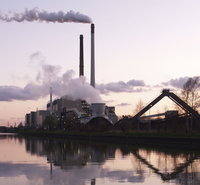
Photo from wikipedia
The Hawaiian Volcano Observatory uses an array of ten fixed, upward-looking ultraviolet spectrometer systems to measure SO2 emission rates at 10-second sample intervals from the Kīlauea summit. We present Kīlauea… Click to show full abstract
The Hawaiian Volcano Observatory uses an array of ten fixed, upward-looking ultraviolet spectrometer systems to measure SO2 emission rates at 10-second sample intervals from the Kīlauea summit. We present Kīlauea SO2 emission rates from the volcano’s summit and Middle East Rift Zone during 2014-2017 and discuss the major sources of error for these measurements. Due to the wide range of SO2 emissions encountered at the summit vent, we used a variable wavelength spectral analysis range to accurately quantify both high and low SO2 column densities. We present case studies comparing the measured emission rates from the fixed spectrometer array to independent road and helicopter-based traverse measurements and evaluate the magnitudes and sources of uncertainties for each method. To address the challenge of obtaining accurate plume speed measurements, we examine ground-based wind-speed, plume speed tracking via spectrometer, and SO2 camera derived plume speeds. Our analysis shows that 1) the summit array column densities calculated using a dual fit window, are within -6 to +22% of results obtained with a variety of other conventional and experimental retrieval methods 2) emission rates calculated from the summit array located ~3 km downwind of the Overlook vent provide the best, practical estimate of summit SO2 release under normal trade wind conditions 3) ground-based anemometer wind speeds are 22% less than plume speeds determined by cross-correlation of plume features 4) our best estimate of average Kīlauea SO2 release for 2014-2017 is 5100 t/d, which is comparable to the space-based OMI emissions of 5518 t/d 5) short-term variability of SO2 emissions reflect Kīlauea lava lake dynamics.
Journal Title: Frontiers in Earth Science
Year Published: 2018
Link to full text (if available)
Share on Social Media: Sign Up to like & get
recommendations!